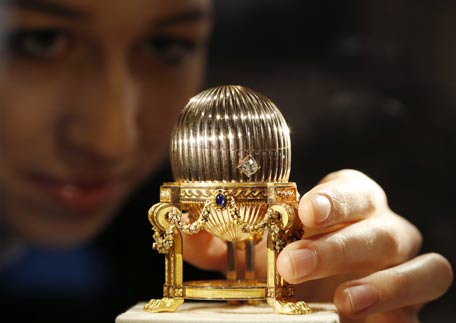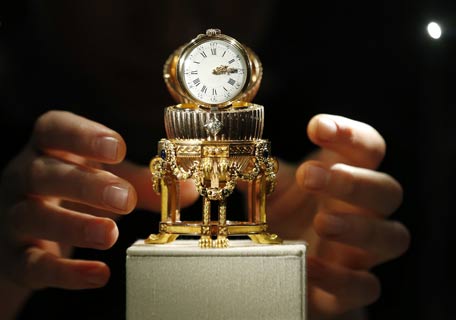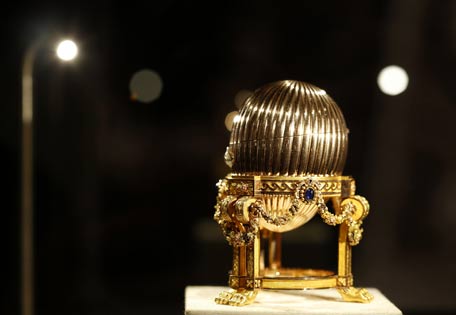- City Fajr Shuruq Duhr Asr Magrib Isha
- Dubai 05:17 06:34 12:07 15:10 17:34 18:50

The $20 million egg, hailing from the court of imperial Russia, was bought in a U.S. junk market by a scrap metal dealer, before it was acquired by Wartski for an unidentified private collector. It will be on display at Wartski's in London for four days in April. (REUTERS)
A Fabergé Imperial Easter Egg made for Emperor Alexander III of Russia and not seen in public for more than a century will go on show in London after being saved from the melting pot by an American scrap dealer who only accidentally realised its value.
The Lost Third Imperial Easter Egg was made by Peter Carl Fabergé as a gift for Empress Maria Feodorovna for Easter 1887.

The 8.2 cm (3.2 inches) tall egg, made from gold and studded with diamonds and sapphires, was last displayed in St Petersburg in 1902.
It was seized by the Bolsheviks during the 1917 Russian Revolution and mysteriously made its way to the United States.
By chance, an unidentified man bought it at a market in the U.S. Midwest for $14,000, intending to sell it for scrap. Unable to find a buyer, he searched the Internet and realised that he may have found Empress Maria Feodorovna's lost Easter egg.
London antiques dealer Wartski, which specialises in the work of Fabergé, bought the egg for an unidentified private collector who has permitted it to go on show in its small showroom near London's luxury shopping strip Bond Street.
"For the art historical community and for the Fabergé world, I think we had to say that it was found. It's like finding a missing Rembrandt and you didn't tell anybody," Kieran McCarthy, director of Wartski, told Reuters.
"It may disappear again and may not be seen for, who knows - I would not be surprised if it didn't come out for another 112 years," he said.

Slightly taller than a cup cake, the ridged yellow gold egg sits on its original tripod with lion paw feet. It is encircled with gold flower garlands strung from cabochon blue sapphires topped with rose diamond-set bows.
Like all Fabergé's eggs, it contains a "surprise" - a lady's watch by Vacheron Constantin with a white enamel face and diamond-set gold hands. The watch has been taken from its case and mounted in the Egg so it can be displayed upright.
The egg was made in the St Petersburg workshop of Fabergé's chief jeweller August Holmstrom between 1886 and 1887.

"In the hierarchy of Fabergé objects, the egg occupies the very, very highest level," said McCarthy. "They each took a year to make from the original conception to the completion of it for delivery on Good Friday each Easter."
Fabergé eggs are considered masterpieces, affordable only by royalty or the very rich. Since the fall of the Soviet Union in 1991, some newly wealthy Russians have become enthusiastic collectors of Fabergé treasures.
Metals tycoon Viktor Vekselberg bought a collection of Fabergé Imperial Easter Eggs for $90 million from the Forbes family in 2004. The eggs were taken back to Moscow and put on exhibition in the Kremlin.
A Russian businessman with a passion for Tsarist treasures, Alexander Ivanov, said he was behind the $18.5 million purchase of a Fabergé egg in London in 2007.
The Third Imperial Easter Egg is one of 50 delivered by Fabergé to Emperors Alexander III and Nicholas II from 1885 to 1916, and until its recent discovery was one of eight lost eggs. Only two others of these lost eggs are thought to have survived the revolution.
"It just shows that you never know," said McCarthy, when asked whether hope remains that the other two will be found. "We never thought this one would turn up and literally it was on somebody who walked through the front door."
The Lost Third Imperial Easter Egg can be seen from April 14 to 17 at Wartski's showroom in London.
![]() Follow Emirates 24|7 on Google News.
Follow Emirates 24|7 on Google News.